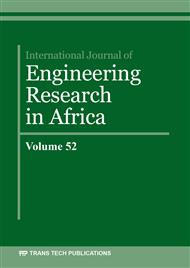[1]
J. P. Novoa and M. A. Rios, Conversion of HVAC Lines into HVDC in Transmission Expansion Planning,, World Academy of Science, Engineering and Technology, International Journal of Electrical, Computer, Energetic, Electronic and Communication Engineering, vol. 11, no. 12, pp.1088-1094, (2017).
Google Scholar
[2]
L. Reed, M. G. Morgan, P. Vaishnav, and D. E. Armanios, Converting existing transmission corridors to HVDC is an overlooked option for increasing transmission capacity,, Proceedings of the National Academy of Sciences, p.201905656, (2019).
DOI: 10.1073/pnas.1905656116
Google Scholar
[3]
D. M. Larruskain, I. Zamora, O. Abarrategui, and Z. Aginako, Conversion of AC distribution lines into DC lines to upgrade transmission capacity,, Electric Power Systems Research, vol. 81, no. 7, pp.1341-1348, 7// 2011, doi: http://dx.doi.org/10.1016/j.epsr.2011.01.020.
DOI: 10.1016/j.epsr.2011.01.020
Google Scholar
[4]
K. Mbangula and I. Davidson, Detailed power system transient stability analysis using expert system concepts and stability improvement of a large multi-machine HVAC network using HVDC technologies,, in Proceedings of the 23rd South African Universities Power Engineering Conference, South Africa, (2015).
DOI: 10.1109/psc.2016.7462873
Google Scholar
[5]
K. Mbangula, O. Oni, and I. Davidson, The Impact of HVDC Schemes on Network Transient Rotor Angle Stability,, in 24th Southern African Universities Power Engineering Conference, South Africa January, (2016).
Google Scholar
[6]
Q. Yang, S. Le Blond, R. Aggarwal, Y. Wang, and J. Li, New ANN method for multi-terminal HVDC protection relaying,, Electric Power Systems Research, vol. 148, pp.192-201, (2017).
DOI: 10.1016/j.epsr.2017.03.024
Google Scholar
[7]
M. A. Elizondo et al., Interarea Oscillation Damping Control Using High-Voltage DC Transmission: A Survey,, IEEE Transactions on Power Systems, vol. 33, no. 6, pp.6915-6923, (2018).
DOI: 10.1109/tpwrs.2018.2832227
Google Scholar
[8]
J. Descloux et al., HVDC meshed grid: Control and protection of a multi-terminal HVDC system,, (2012).
Google Scholar
[9]
P. Rodriguez and K. Rouzbehi, Multi-terminal DC grids: challenges and prospects,, Journal of Modern Power Systems and Clean Energy, vol. 5, no. 4, pp.515-523, (2017).
DOI: 10.1007/s40565-017-0305-0
Google Scholar
[10]
O. E. Oni, A. G. Swanson, and R. P. Carpanen, Small Signal Stability Analysis of a four Machine System with Strategic Placement of Monopolar LCC-HVDC link,, in 2019 Southern African Universities Power Engineering Conference/Robotics and Mechatronics/Pattern Recognition Association of South Africa (SAUPEC/RobMech/PRASA), 2019: IEEE, pp.437-443.
DOI: 10.1109/robomech.2019.8704735
Google Scholar
[11]
C. Canizares et al., Benchmark models for the analysis and control of small-signal oscillatory dynamics in power systems,, IEEE Transactions on Power Systems, vol. 32, no. 1, pp.715-722, (2016).
Google Scholar
[12]
O. E. Oni, A. G. Swanson, and R. P. Carpanen, Small signal stability analysis of a four-machine system with placement of multi-terminal high voltage direct current link,, Journal of Energy in Southern Africa, vol. 31, no. 1, pp.73-87, (2020).
DOI: 10.17159/2413-3051/2020/v31i1a7430
Google Scholar
[13]
O. E. Oni, A. G. Swanson, and R. P. Carpanen, Impact of LCC–HVDC multi-terminal on generator rotor angle stability,, International Journal of Electrical and Computer Engineering, vol. 10, no. 1, p.22, (2020).
DOI: 10.11591/ijece.v10i1.pp22-34
Google Scholar
[14]
O. E. Oni, A. G. Swanson, and R. P. Carpanen, Modelling and control of multi-terminal LCC HVDC,, in 2018 IEEE PES/IAS PowerAfrica, 2018: IEEE, pp.274-279.
DOI: 10.1109/powerafrica.2018.8520967
Google Scholar
[15]
X. Yang, C. Yuan, D. Yao, C. Yang, and C. Yue, Dynamic performance of series multi-terminal HVDC during AC faults at inverter stations,, in 2014 16th European Conference on Power Electronics and Applications, 2014: IEEE, pp.1-9.
DOI: 10.1109/epe.2014.6910817
Google Scholar
[16]
O. E. Oni, A. G. Swanson, and R. P. Carpanen, Impact of Partial De-blocking of MTDC Link during DC Fault,, in 2019 IEEE PES/IAS PowerAfrica, Abuja, Nigeria, IEEE, Ed., 2019: IEEE.
DOI: 10.1109/powerafrica.2019.8928915
Google Scholar
[17]
R. L. Vasquez-Arnez, J. A. Jardini, and M. T. Bassini, Dynamic Performance of Line Commutated Converter-Based Multiterminal HVDC Systems,, Przegląd Elektrotechniczny, vol. 91, no. 9, pp.247-253, (2015).
DOI: 10.15199/48.2015.09.62
Google Scholar
[18]
E. Ruppert Filho, F. L. Nunes Jr, and S. O. Nunes, Synchronous machine fild current calculation taking into account the magnetic satuartion,, Sba: Controle & Automação Sociedade Brasileira de Automatica, vol. 13, no. 2, pp.165-170, (2002).
DOI: 10.1590/s0103-17592002000200008
Google Scholar
[19]
P. Kundur, N. J. Balu, and M. G. Lauby, Power system stability and control. McGraw-hill New York, (1994).
Google Scholar
[20]
Voltage Dependent Current Limits., https://hvdc.ca/webhelp/Master_Library_Models/HVDC_and_FACTS/HVDC_Controls/Voltage_Dependent_Current_Limits.html (accessed 2019).
DOI: 10.3403/30427156u
Google Scholar
[21]
D. Jacobson, P. Wang, C. Karawita, R. Ostash, M. Mohaddes, and B. Jacobson, Planning the next nelson river HVDC development phase considering LCC vs. VSC technology,, in 2012 CIGRE Session, Aug 26–31, 2012, Paris, France: CIGRE, 2012, B4–103: 1–12, (2012).
Google Scholar
[22]
M. Eremia, C.-C. Liu, and A.-A. Edris, Advanced solutions in power systems: HVDC, FACTS, and Artificial Intelligence. John Wiley & Sons, (2016).
DOI: 10.1002/9781119175391
Google Scholar


